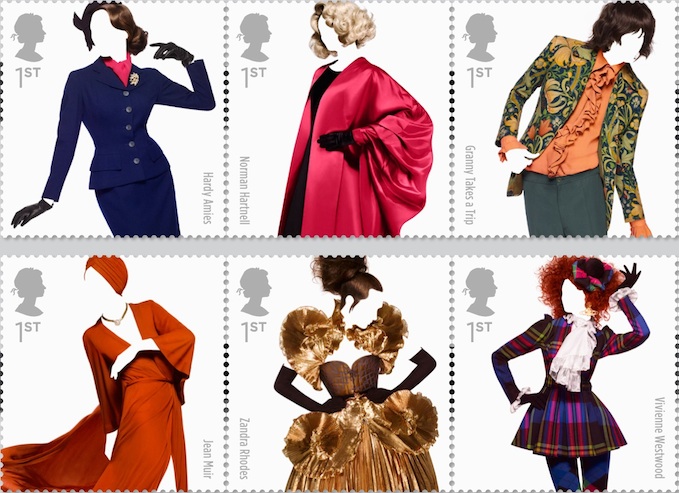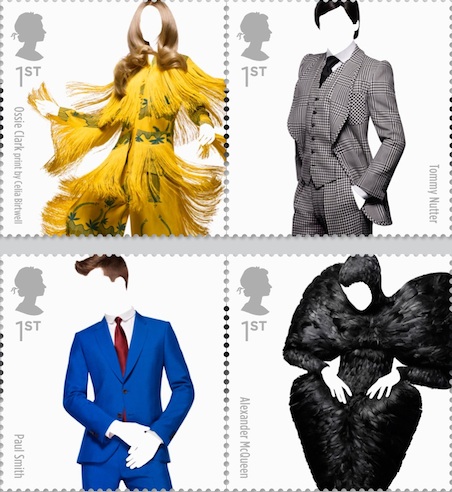| |
2012 Stamp Issues
5th Jan 2012 - Olympics
and Paralympics Stamp Booklet
Tues 10th Jan 2012 - Roald
Dahl
Thurs 2nd Feb 2012- The
House of Windsor
6th February - Diamond
Jubilee
Thurs 23rd Feb 2012 - Britons of Distinction
Thurs 8th March 2012 - Classic Locomotives of Scotland
Tuesday 20th March 2012 - Comics
Tuesday 10th April 2012 - UK A-Z Part 2
Tues 15th May 2012 - Great British Fashion
Thurs 31st May 2012 - The Diamond Jubilee
Tues 19th June 2012 - Charles Dickens
Tues 27th July 2012 - Olympic Games Welcome
Wed 29th August 2012 - Paralympic Games Welcome
Thurs 27th Sept 2012 - Olympic & Paralympic Games Memories
Tues 16th Oct 2012 - Dinosaurs
Tues 30th Oct 2012 - Space Science
Tues 6th Nov 2012 - Christmas
|
|
Great British Fashion
Issue Date - 15th May 2012
Britain is famous around the world for the creative vision of its fashion designers, its refi ned Savile Row tailoring, its shoemakers, milliners – not forgetting its fi ne wool fabrics and yarn.
Since 1945, fashion has grown to become a major national industry. Today it employs about a million people and contributes directly some £21 billion to the UK economy.
This issue showcases the very best of post-war fashion, featuring the innovative fashion houses that have put the UK in the top rank of world fashion design, and showcasing a prime example of each selected designer’s work.
The idea for the issue came from the British Design Classics stamps of 2009, which featured the stylish chic of Mary Quant’s daring mini skirt. This proved to be one of the most popular of the ten stamps featured in the issue; prompting the decision to dedicate an entire issue to our world-class designers.
Issue Products
 
|
1st Class – Hardy Amies
.... became managing director of Mayfair couture house Lachesse in 1934. After World War II he opened his own fashion business in Savile Row. Amies was the first major European fashion designer to venture into ready-to-wear and in 1955 received a Royal Warrant as dressmaker to the Queen. Other commissions have included clothing for the 1966 England World Cup squad and the 1972 GB Olympic squad and the film 2001: A Space Odyssey. The Amies’ outfit shown on the stamp dates from the late 1940s.
|
| |
1st Class – Norman Hartnell
.... opened his first couture house at 10 Bruton Street, Mayfair in 1923. In 1940 he received a Royal Warrant as dressmaker to Queen Elizabeth, subsequently Royal Warrant as dressmaker to HM Queen Elizabeth The Queen Mother. A Royal Warrant as dressmaker to Queen Elizabeth II was issued in 1957. The stamp shows an outfit created by Hartnell in the 1950s.
|
| |
1st Class – Granny Takes a Trip
.... was a boutique opened in February 1965 at 488 Kings Road in London’s Chelsea, by Nigel Waymouth, his girlfriend Sheila Cohen and John Pearse. The shop, which was acquired by Freddie Hornik in 1969,
remained open until the mid-70s and has been called the ‘first psychedelic boutique in Groovy London of the 1960s’. The jacket shown on the stamp was designed by John Pearse using a Morris & Co. furniture fabric print called Golden Lily (1899).
|
| |
1st Class – Ossie Clark print by Celia Birtwell
Raymond ‘Ossie Clark’ was a major figure in the Swinging Sixties scene in London and the fashion industry in that era. Clark is now renowned for his vintage designs by present-day designers and compared to the 1960s fashion greats Mary Quant and Biba. He has influenced many other designers, including Yves Saint Laurent, Anna Sui and Tom Ford. The outfit shown on the stamp dates from the late 1960s and features a print by Celia Birtwell.
|
| |
1st Class – Tommy Nutter
.... recreated the Savile Row suit in the 1960s. In 1969, he joined up with Edward Sexton, to open Nutters of Savile Row. Nutter combined traditional tailoring skills with innovative design. His clients included Mick Jagger and Elton John. Nutter was most proud of the fact that he dressed three out of the four Beatles on the cover of the LP Abbey Road. The suit featured on the stamp was originally designed for
Ringo Starr and has been recreated especially for the photo shoot.
|
| |
1st Class – Jean Muir
..worked briefly in a solicitor’s office before taking a stockroom job at Liberty & Co in 1950. Despite her lack of formal art college training, she was given the opportunity to sketch in Liberty’s ready-to-wear department, which led to her gaining a job as designer for Jaeger in 1956. Her own label Jean and Jane was launched in 1962 followed by Jean Muir Ltd in 1966. Famous clients include former Muir model
Joanna Lumley, Charlotte Rampling and Maggie Smith. The outfit featured here dates to the late 70s / early 80s.
|
| |
1st Class – Zandra Rhodes
.... was one of the new wave of British designers who put London at the forefront of the international fashion scene in the 1970s. Her designs are considered clear, creative statements, dramatic but graceful, bold but feminine. Rhodes’s inspiration has been from organic material and nature. Her approach to the construction of garments can be seen in her use of reversed exposed seams and in her use of jewelled safety pins and tears during the punk era.
With her bright green hair (later pink and sometimes red or other colours), theatrical makeup and art jewellery, she stamped her own clear identity on the international world of fashion. Rhodes designed for Diana, Princess of Wales, and continues to design for royalty and celebrities. She notably designed several outfits for Freddie Mercury. The early 80s gold ‘Royal’ dress shown here comes from Zandra Rhodes’s personal collection.
|
| |
1st Class – Vivienne Westwood
.... is largely responsible for bringing punk fashion into the mainstream. In the mid-1970s with Malcolm McLaren, Westwood created clothes drawing inspiration from bikers, fetishists and prostitutes, which McLaren sold from his Kings Road boutique. When McLaren became manager of the Sex Pistols, the band wore Westwood and McLaren’s designs. The ‘punk style’ included bondage gear, safety pins, razor
blades, bicycle or lavatory chains on clothing and spiked dog collars for jewellery. Westwood’s work includes the adoption of traditional elements of Scottish design, such as tartan fabric, and the reinterpretation of 17th and 18th century cloth cutting principles.
Her first catwalk show was presented in 1981, featuring the collaboration of Westwood and McLaren. The first major retrospective of her work was shown in 2004–05 at the Victoria and Albert Museum in London. The 1993 Harlequin dress shown here was famously modeled by Naomi Campbell
|
| |
1st Class – Paul Smith
.... left school at 15 with the ambition of becoming a racing cyclist. A cycling accident put an end to his cycling hopes, and during the six-month hospital stay that followed Smith made some new friends. After leaving hospital he arranged to meet them at a local pub that was popular with art students. It was then that he realised he wanted to be a designer. Smith took evening tailoring classes with Gordon Valentine Tipton, who showed him how to cut cloth as well as taught him all the basics. Later Smith joined Lincroft Kilgour in Savile Row, where his designs were worn by celebrities, including George Best. He opened his fi rst shop in 1970. In 1976 Smith’s first menswear collection was shown in Paris, under the Paul Smith label. In 1998, he showed his first women’s collection at London Fashion Week.
Paul Smith remains fully involved in the business, designing clothes, choosing fabrics, approving the shop locations and overseeing every development within the company. He has showrooms in London, Paris, Milan, New York and Tokyo. The suit on the stamp dates from around 2003.
|
| |
1st Class – Alexander McQueen
.... was a fashion designer and couturier best known for his in-depth knowledge of bespoke British tailoring, his tendency to juxtapose strength with fragility in his collections, as well as the emotional power and raw energy of his provocative fashion shows. He worked as chief designer at Givenchy from 1996 to 2001 and founded his own label under the name Alexander McQueen. His achievements have
earned four British Designer of the Year awards (1996, 1997, 2001 and 2003), as well as the CFDA’s International Designer of the Year award in 2003. The piece shown on the stamp is ‘Black Raven’ from McQueen’s Horn of Plenty 2009 collection.
|
|
Technical Details
The stamps were designed by Johnson Banks, and are printed by Cartor Security Printing in lithography. The 35x37mm square stamps are perf 14.5 in sheets of 25/50. The stamps in row 1 are in one sheet of 25 (5x5), the stamps in row 2 are in a second sheet of 25, enabling vertical strips of 5 of any single design to be obtained.
|
|



